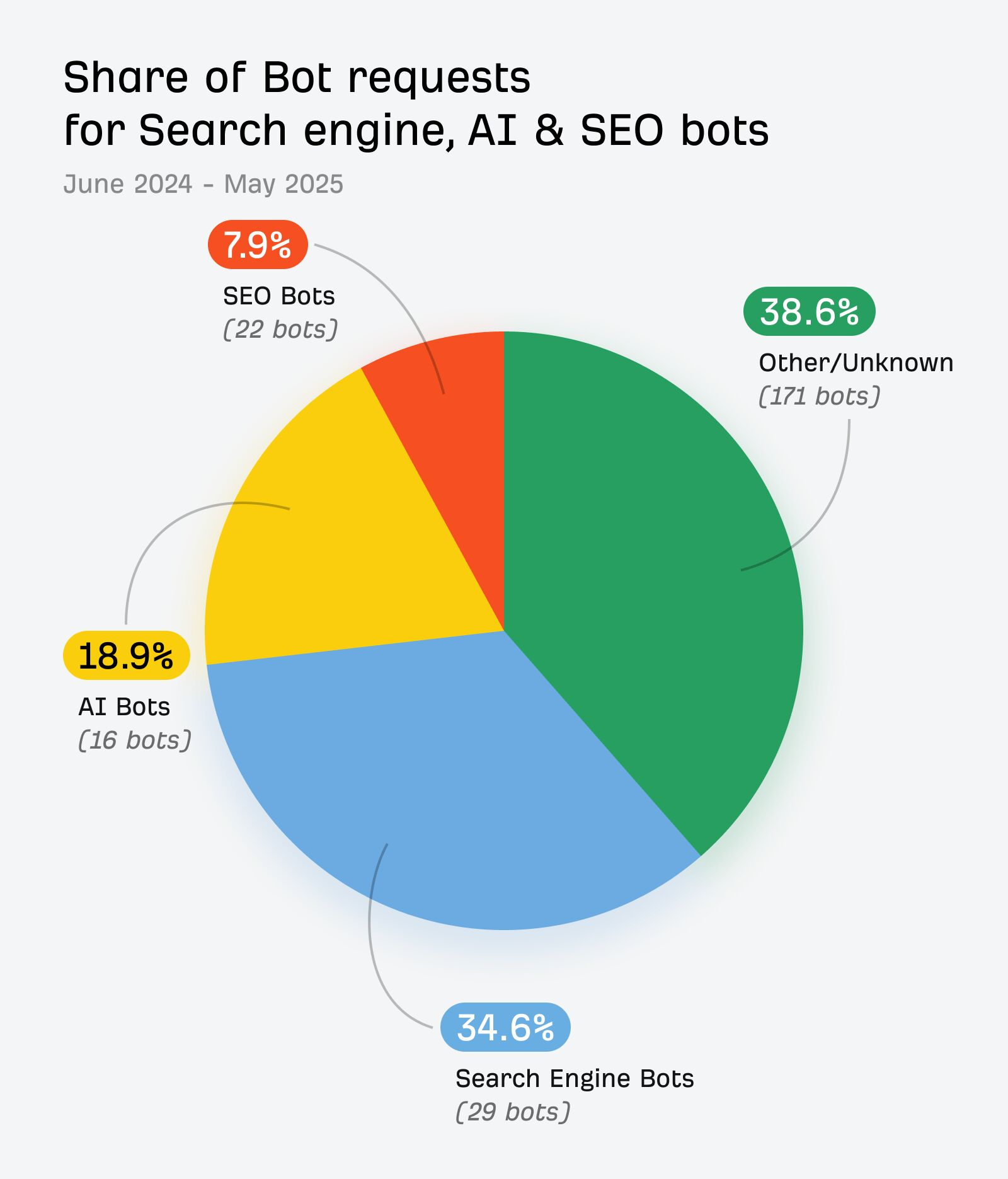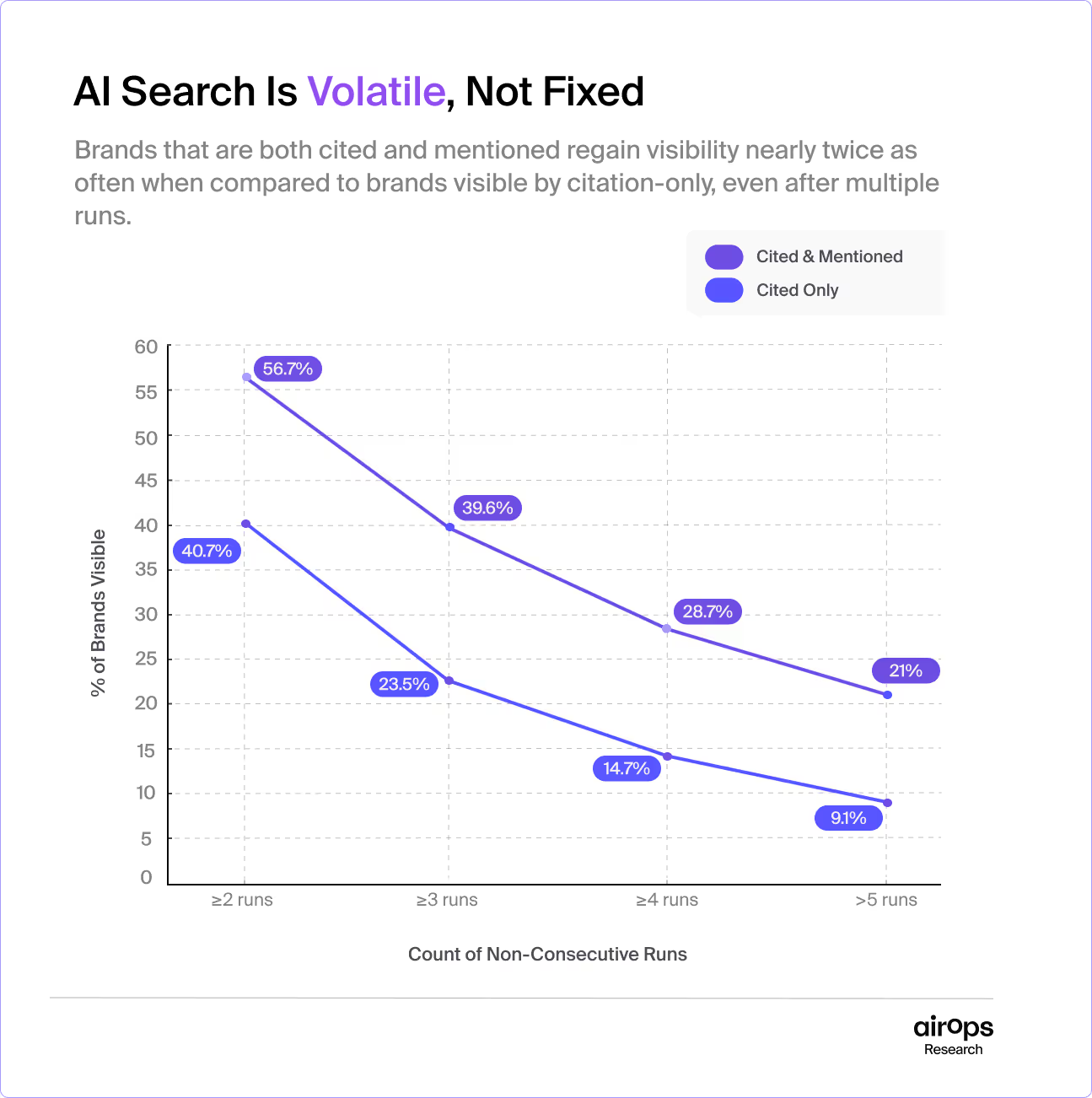50 Essential AI Search Statistics for 2025: Visibility, Citations, and Consumer Behavior
AI-driven search is reshaping how people discover information, evaluate brands, and make purchasing decisions. Instead of clicking through search results, users now get instant, conversational answers from systems like ChatGPT, Perplexity, Gemini, and Google AI Mode.
This report compiles 50 verified statistics from 2024–2025 across Gartner, BrightEdge, Yext, Ahrefs, Superlines, and others. It highlights how AI Search adoption, traffic, and citation behavior are redefining digital visibility and what that means for marketers in an AI Search era.
Use this data to benchmark your performance, spot early opportunities, and understand how AI-driven discovery is replacing traditional search visibility metrics.
AI Search Adoption and Market Growth
The following data highlights how AI search platforms like ChatGPT, Perplexity, and Gemini are driving global adoption and transforming discovery behavior. AI Search adoption is accelerating globally, redefining how consumers find and evaluate brands online, marking a fundamental shift from keyword-based discovery to AI-generated answers. Over 1.1 billion people are expected to use AI by 2031, making it one of the fastest-adopted technologies in history.
- 36% of U.S. adults will use generative AI for online search by 2028
- 60% of marketing teams plan to reallocate part of their SEO budgets toward AI Search optimization by 2026 according to BrightEdge’s 2025 research.
- Gartner study revealed that Generative AI usage for content discovery grew 156% YoY as search behavior shifted from queries to conversations.
- Google AI Overviews now appear in 13.1% of U.S. desktop searches, up 72% since January 2025
- Google AI Mode has now been rolled out globally in October 2025. AI Mode will be available in over 200 countries and territories total, including many across Europe.
- Gemini AI Search expanded to 23 global markets in Q2 2025, marking Google’s fastest geographic rollout of an AI-powered search product.
As adoption accelerates, user behavior and trust patterns reveal how generative AI is already influencing daily decision-making.
To dive deeper into how to create content that AI systems understand and recommend, explore our guide on best practices for optimizing content for generative AI.
Shifts in Consumer Behavior and Trust
These statistics reveal how consumer trust, verification habits, and generational patterns are evolving as AI assistants become a daily search habit. As adoption scales, user trust and engagement patterns reveal how deeply AI Search is shaping daily discovery. Consumers are blending traditional search with AI assistants, but trust and verification behaviors remain complex. AI SEO trends: 60% of searches are now completed without users clicking through to other websites.
- 51% of U.S. adults said they’ve used AI to look up the answer to a question.
- 65% of AI users are Millennials or Gen Z.
- By 2028, 50% of all online searches will involve an AI assistant according to Gartner.
These figures show how quickly AI Search is shifting from experiment to daily habit.
43% of consumers now use AI tools daily. While 68% use AI for local product/service research, only 19% trust AI results compared with 45% for traditional search engines
Consumers are increasingly relying on AI tools to discover, evaluate, and buy from brands. Trust in local product/service research is low.
Nearly two-thirds (62%) of consumers trust AI to guide brand choices, matching traditional search during key decision-making moments. That’s one big finding from Yext’s new report, AI Search Archetypes.
By the numbers. Nearly three-quarters (75%) of people say they’re using AI Search tools more than they did a year ago. And 43% use them daily or more. Also:
This is a Generational divide. Millennials lead for cross-platform searches, often turning to AI for quick clarity but relying on search engines (69%) for detailed product info. Meanwhile:
Gen Z leans on AI for brainstorming and how-to help (48% each) and mixes in social media (45%) for ideas.
Gen X uses AI for deeper context and summaries but sticks with traditional search (70%) for general knowledge.
Boomers remain AI holdouts, 26% don’t use it for common tasks, and 80% rely on traditional search engines. Why this matters?
Despite rapid adoption, consumers don’t blindly trust AI. Most double-check responses, meaning brands must ensure consistent, structured information across channels and platforms to stay visible and credible.
About the data. The findings are from a March–April online survey of 2,237 adults in the U.S., UK, France, and Germany who purchased online within the last three months and used voice or conversational AI to find information. The study was conducted by Researchscape International for Yext.
The report can be found here: 2025 AI Search Archetypes
As user trust patterns evolve, visibility data shows that AI Search is already influencing measurable shifts in organic traffic sources.
- 82% of Gen Z users prefer AI tools that provide direct answers over traditional web search.
- 39% of U.S. adults use ChatGPT weekly for decision-making tasks such as comparing products or services.
- 62% of consumers say they trust AI recommendations more when brand citations include source links.
AI Search is no longer experimental since it’s becoming the primary discovery layer for users worldwide. To learn how to improve your brand’s visibility in AI-powered search results, read our in-depth guide on Generative Engine Optimization (GEO) also referred to as Answer Engine Optimization (AEO).
These behavioral shifts directly impact how AI search engines index, cite, and rank brand content. The results are already visible in measurable traffic trends.
AI Search Traffic and Visibility Trends
The next set of data shows how AI-powered platforms are reshaping web traffic patterns, content visibility, and measurement across industries. Visibility data confirms that AI Search is already measurable across industries. Early adopters see clear shifts in where organic discovery originates.
As of 2025, ChatGPT processes over 1B daily queries, with 800M weekly active users globally. It accounts for roughly 80% of all generative AI traffic. (Superlines analysis of Similarweb & Statista data, 2025).
Even as AI Search traffic grows quickly, it’s still early days compared to traditional search.
To put things in perspective, according to Cloudflare:
ChatGPT only ranks #45 among global websites
Pinterest (which ranks #44) has ~10M more monthly users than ChatGPT
Bing (which ranks #15) drives 2–3x more search traffic than ChatGPT
Perplexity.ai reached 70 million monthly visits in Sept 2025, +330 % YoY.
- 84% of marketers report measurable traffic changes tied to AI Search adoption.
- In a BrightEdge study, pages updated within 60 days are 1.9× more likely to appear in AI answer.
- Sites implementing structured data and FAQ blocks saw a 44% increase in AI Search citations in a study by BrightEdge.
- AI-search-advertising spend is expected to grow from $1 B in 2025 to $26 B by 2029, showing rapid monetization according to Reuters. (Reuters 2025).
That said, now that Google’s AI Mode is finally rolling out globally, adoption is sure to accelerate.
12% of US survey respondents said AI-powered search results were more trustworthy.
In a research by GWI, a third of the users were using ChatGPT to conduct searches and they had the most positive experience from all of the users when searching online.
Statista reports rising voice-assistant usage (2024), reinforcing the overall shift toward conversational search interfaces. AI is accelerating the adoption of voice search, since 90% of searchers find it easier than typing out a search query.
In a study by Yext, 86% of AI citations came from brand-controlled content (websites/listings) rather than forums. This finding cuts through confusion about the role of forums like Reddit and provides marketers with trusted data to guide strategy as consumers rapidly adopt AI Search.
Brands in the top 25% for web mentions get 10 × more AI visibility than others; the top 50 brands receive about 28.9% of all mentions in AI Overviews.
Beneath these visibility shifts lies a more technical transformation; the rise of AI bots that crawl, index, and interpret content differently than traditional search engines.
For a deeper breakdown of how AI search engines surface and rank content, see our guide on How to Optimize for AI Search Results in 2025. It explains how large language models decide what to cite — and what brands can do to improve their presence across ChatGPT, Perplexity, Gemini, and other major AI platforms.
AI bot behavior
AI crawlers now act as the invisible backbone of search visibility, indexing and interpreting web content in new ways that directly affect brand mentions and citations. AI bots are quickly catching up to traditional search crawlers. These stats from Ahrefs (May 2025) show how fast they’re growing, which bots are most blocked, and what that means for publishers
managing traffic and server load.
The number of AI bots has doubled since August 2023, with 21 major AI bots now active on the web.
GPTBot (OpenAI) is the most blocked AI bot, with 5.89% of all websites blocking them.
ClaudeBot (Anthropic) saw the highest growth in block rates, increasing by 32.67% over the past year.
AI bots are increasing their crawling activities, reaching 2nd place behind search engine bots and contributing to 25% of requests.
Ultimately, the goal of these crawlers is determining which brands get mentioned and cited inside AI answers.

Beyond user interaction, understanding how AI crawlers index and cite content has become essential for maintaining visibility across ChatGPT, Gemini, and Perplexity.
That said, server-side bot analytics are not mandatory to start improving your AI Search visibility. They’re valuable for large organizations with the technical resources to act on that data, but they aren’t a prerequisite for growth. Implementing them requires some engineering setup, and while the insights can be useful, they don’t directly increase visibility on their own.
For most teams, the best starting point is to measure your current AI Search visibility and focus on optimizing and expanding content. Close content gaps between you and your competitors, strengthen topic authority, and position your site as a trusted knowledge hub that AI systems recognize and cite as a source. Once that foundation is in place, server-level analytics can complement your efforts with deeper insights.
Brand Citations, Volatility, and Optimization Insights
Being cited in AI answers is becoming the new visibility benchmark. The data shows how volatile, but measurable, that landscape is. Only ~30% of brands remained visible in back-to-back responses in AI Search; visibility is volatile even for high-performing brands.

- BrightEdge’s 2025 Schema study reveals that websites with author schema were 3× more likely to appear in AI answers
- According to Edelman Insights 90% of AI citations driving brand visibility originate from earned and owned media, not paid placements.
Consistent Visibility Is the Exception
According to AirOps analysis, they found that some brands managed to hold steady in AI Search results–but they’re the exception, not the rule. Out of more than 45,000 citations, only 1 in 5 brands had maintained visibility from the first run to the fifth.

The consistently cited pages shared common traits: structured elements like rich schema, sequential headings, scannable formatting, and concise language—all signals that help both users and models interpret content more effectively.
This observation also aligns with their earlier research on content structure, which found that pages with well-organized headings were 2.8× more likely to earn citations in AI Search results. This pattern also aligns with Superlines’ 2025 benchmark findings.
Turning Volatility Into an Advantage
AI Search is volatile by design, but maintaining visibility across answer engines doesn’t have to mean guesswork. The key is to build measurement practices that account for fluctuation, identify patterns, and separate real signals from expected noise.
Here’s how teams can use volatility to their advantage with Superlines:
- Anchor on first occurrences to establish a baseline for visibility.
- Track both mentions and citations to capture authority signals the model is using.
- Use structured measurement windows to avoid overreacting to short-term fluctuation.
- Refresh content regularly and monitor early traction to understand which updates sustain visibility.
Fluctuation is inevitable, but measurable.
Ready to get started?
The next phase of marketing visibility will be defined by how clearly your brand communicates structured, verifiable, and AI-readable information across every channel. As AI engines evolve from assisting to deciding, visibility will depend less on backlinks and more on how clearly your brand communicates structured, trustworthy information across every digital surface.
Start tracking your brand’s AI search visibility with Superlines today, to see where you already appear and where untapped opportunities still exist across ChatGPT, Perplexity, and Google AI Mode.
For a deeper, strategic breakdown of how to operationalize these tactics inside your marketing team, see our 10-Step GEO Guide for 2025.
The future of search belongs to brands that understand how AI sees the web. Start optimizing for visibility inside answers, not just rankings and you’ll define how your market discovers you.
Compiled by Superlines Research Team, October 2025
.svg)
.svg)
.svg)
.svg)


